Golden Age conventions
A series of deaths, the first one an apparent accident, takes place in the normally quiet cathedral town of Welchester, more particularly within the "Close" of the 500-year old cathedral itself, "Close" being the English word for the precincts of a cathedral. "Educated at Blundell’s, a well-known private school, and London University, Gilbert had a short spell as a schoolteacher before the Second World War.... By then his enthusiasm for detective fiction had prompted him to start work on Close Quarters... conceived in the spirit of Golden Age mystery writing." [3] Golden Age mysteries had been popularized throughout the 1930s by writers such as Agatha Christie, Dorothy L. Sayers, and Michael Innes and had informally created a number of conventions that are to be found in Close Quarters.
The setting here is the tightly limited confines of the cathedral Close and those few houses within its exterior walls, much as many Golden Age stories were set in isolated country houses; two full pages are devoted to a complete cast of the "householders" inhabiting the Close; the main characters (and suspects) are strictly limited to those ecclesiastics living within these confines; we have three full-page diagrams showing the grounds of the Close with its cathedral and houses; an inspector and detective sergeant are sent down from Scotland Yard to conduct the inquiries; a loving imitation of a London Times crossword puzzle is presented, along with its recondite clues, and is the subject of an entire chapter, with three iterations of the puzzle itself being shown as it is gradually filled in by two of the story's scholarly characters; there is much leisurely description of the cathedral, the neighboring houses, and of the characters themselves; and there is one lengthy red herring in which the detective sergeant [4] follows two of the suspects to London to no great purpose. And finally, of course, Inspector Hazlerigg deduces the identity of the murderer, contrives to trick him into an incriminating act, and then explains all of the story's most baffling events to a gathering of the surviving characters.

Ellery Queen is a pseudonym created in 1928 by the American detective fiction writers Frederic Dannay (1905–1982) and Manfred Bennington Lee (1905–1971). It is also the name of their main fictional detective, a mystery writer in New York City who helps his police inspector father solve baffling murder cases. From 1929 to 1971, Dannay and Lee wrote around forty novels and short story collections in which Ellery Queen appears as a character.
Michael Francis Gilbert was an English solicitor and author of crime fiction.

Peter Harmer Lovesey, also known by his pen name Peter Lear, is a British writer of historical and contemporary detective novels and short stories. His best-known series characters are Sergeant Cribb, a Victorian-era police detective based in London, and Peter Diamond, a modern-day police detective in Bath.

The Killings at Badger's Drift is a mystery novel by English writer Caroline Graham and published by Century in 1987. The story follows Chief Inspector Tom Barnaby investigating the murder of an elderly spinster in a rural village. It is the first volume in Graham's Chief Inspector Barnaby series, followed by Death of a Hollow Man. In 1997, it was adapted as the pilot of Midsomer Murders, a popular ITV television series based on Graham's books.
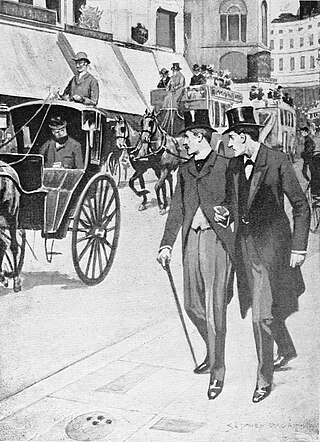
The amateur detective, or sometimes gentleman detective, is a type of fictional character. He has long been a staple of crime fiction, particularly in detective novels and short stories set in the United Kingdom in the Golden Age. The heroes of these adventures are often members of the British gentry or gentlemen by conduct. They are sometimes contrasted with professional police force detectives from the working classes.

Smallbone Deceased is a 1950 mystery novel by the English author Michael Gilbert, published in the United Kingdom by Hodder and Stoughton and in the United States by Harper & Brothers. A practising lawyer himself, Gilbert made the setting of the novel a London solicitor's office. The book was Gilbert's fourth novel and, like his three earlier ones, features Chief Inspector Hazlerigg. The novel was well-received and has regularly appeared in "Top 100" crime lists. Some critics consider it to be Gilbert's best work.
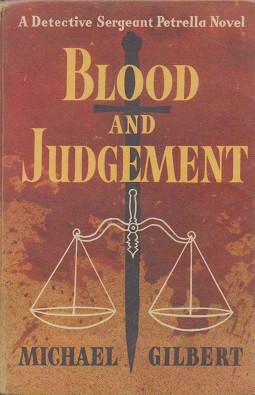
Blood and Judgement is a police procedural novel by the British author Michael Gilbert. Published in England in 1959 as Blood and Judgement by Hodder and Stoughton and in the United States as Blood and Judgment by Harper & Brothers, it was Gilbert's tenth novel. Gilbert, who was appointed CBE in 1980, was a founder-member of the British Crime Writers' Association. The Mystery Writers of America named him a Grand Master in 1988 and in 1990 he was presented Bouchercon's Lifetime Achievement Award. It introduces his most notable series character, Patrick Petrella, as a young and already somewhat controversial Detective Sergeant working out of the fictional Q Division of the Metropolitan Police Area.

Fear to Tread is a mystery–crime thriller by the British mystery writer Michael Gilbert, first published in 1953 by Hodder and Stoughton in England and by Harper & Brothers in the United States. Set mostly in London, it was his seventh novel in six years and built upon the favourable reputation he had achieved earlier with the well-received Smallbone Deceased and Death Has Deep Roots. Gilbert, who was appointed CBE in 1980, was a founder-member of the British Crime Writers' Association. The Mystery Writers of America named him a Grand Master in 1988 and in 1990 he was presented Bouchercon's Lifetime Achievement Award. It is one of numerous stories and novels by Gilbert presenting a gritty, realistic depiction of organized gangs, frequently directed by a deeply concealed mastermind who is not unearthed until the final pages.

Stay of Execution is a collection of mystery stories by the British thriller writer Michael Gilbert, first published in 1971 by Hodder & Stoughton. Gilbert, who was appointed CBE in 1980, was a founder-member of the British Crime Writers' Association. The Mystery Writers of America named him a Grand Master in 1988 and in 1990 he was presented Bouchercon's Lifetime Achievement Award. Unusually for a collection of stories, its reprint edition by House of Stratus in 2011 has no index detailing the stories in the book. The longest story, by far, is the last one in the book, Stay of Execution. At 54 pages, it is what is generally called a novella. Two of the stories feature Chief Superintendent Hazlerigg; three Henry Bohun; and one Detective Inspector Petrella, characters who have figured in other short stories and novels by Gilbert. The Independent said of the book in 2006:
Gilbert had a fondness for amusing but unscrupulous pirates... and an entirely practical, indeed sceptical, view of the workings of the law. It was typical of his humour that the two stories in his excellent collection Stay of Execution (1971) in which rascally solicitors "get away with it", "Back on the Shelf" and "Mr Portway's Practice", were written in the first person.

The Man Who Hated Banks is a collection of mystery stories by the British thriller writer Michael Gilbert, first published in 1997 by the American company Crippen & Landru. As the back cover of the book tells us, it was "published in honour of the fiftieth anniversary of Michael Gilbert's first book." Gilbert, who was appointed CBE in 1980, was a founder-member of the British Crime Writers' Association. The Mystery Writers of America named him a Grand Master in 1988 and in 1990 he was presented Bouchercon's Lifetime Achievement Award. It has an Introduction by the author and contains 18 of his previously uncollected stories, all of them concerning characters who have figured in other novels and short stories. Seven of the stories feature Chief Inspector Hazlerigg; five Henry Bohun; three Detective Chief Inspector Mercer; and three Detective Inspector Petrella.
Inspector Hazlerigg is a police detective created by the British mystery writer Michael Gilbert who appears in six novels published between 1947 and 1958, as well as in 20 short stories. Although he plays a key role in each of the novels, he is far from being the main character in all of them; in some, particularly Death Has Deep Roots and Fear to Tread, his page appearances are quite limited. In his first appearance, in the Golden Age mystery novel Close Quarters, which takes place in 1937, Hazlerigg is a Chief Inspector at New Scotland Yard in London. By the final novel in the series, Fear to Tread, he has become a Chief Superintendent.
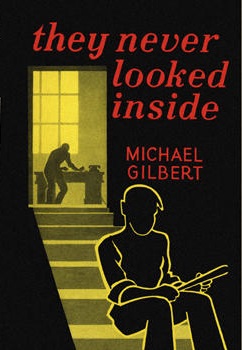
They Never Looked Inside is the second novel by the British mystery writer Michael Gilbert. It was published in England by Hodder and Stoughton in 1948 and in the United States by Harper & Brothers in 1949 as He Didn't Mind Danger. It was Gilbert's first publication in the States. It is also the second novel to feature Gilbert's earliest recurring character, Inspector Hazlerigg. Gilbert, who was appointed CBE in 1980, was a founder-member of the British Crime Writers' Association. The Mystery Writers of America named him a Grand Master in 1988 and in 1990 he was presented Bouchercon's Lifetime Achievement Award.

Amateur in Violence is a collection of mystery stories by the prominent British thriller writer Michael Gilbert, published in the United States in 1973 by Davis Publications, a publishing house for magazines, but not in England. Gilbert, who was appointed CBE in 1980, was a founder-member of the British Crime Writers' Association. The Mystery Writers of America named him a Grand Master in 1988 and in 1990 he was presented Bouchercon's Lifetime Achievement Award. The book is edited, and has an introduction, by Ellery Queen, the founder and long-term editor of Ellery Queen's Mystery Magazine. It contains 10 stories and a short novel that had been previously uncollected in the United States. Some of them feature characters who have figured in other novels and short stories by Gilbert. Three stories feature Inspector Hazlerigg and four Inspector Petrella. The short novel, "Stay of Execution", had previously given its name to the title of a collection published in England in 1971.

The Curious Conspiracy is a collection of mystery stories by the British thriller writer Michael Gilbert, first published in 2002 by the American company Crippen & Landru and then in England. Published to recognize Gilbert's 90th birthday, it contains 20 previously uncollected stories, as well as a brief introduction by Gilbert himself and an appendix for Sources. Gilbert, who was appointed CBE in 1980, was a founder-member of the British Crime Writers' Association. The Mystery Writers of America named him a Grand Master in 1988 and in 1990 he was presented Bouchercon's Lifetime Achievement Award. Four of the stories in this collection feature two of Gilbert's many recurring characters that he created throughout his long career of writing both novels and short stories. Gilbert's introduction says that the topics covered by the stories are "catholic", in the sense of being "of universal human interest; touching the needs, interests or sympathies of all men." The locales vary from London to a Red Sea sheikdom and the time frame from the present day back to the Peninsular War. Some of them, such as "Judith", have an unexpected grimness about them. "Michael was an exceptionally fine storyteller, but he's hard to classify," said one of his British publishers after his death. "He's not a hard-boiled writer in the classic sense, but there is a hard edge to him, a feeling within his work that not all of society is rational, that virtue is not always rewarded.".
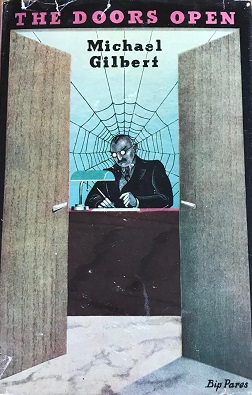
The Doors Open, published by Hodder and Stoughton in England in 1949 and by Walker and Company in the United States in 1962, is the third novel by the British mystery and thriller writer Michael Gilbert. Gilbert, who was appointed CBE in 1980, was a founder-member of the British Crime Writers' Association. The Mystery Writers of America named him a Grand Master in 1988 and in 1990 he was presented Bouchercon's Lifetime Achievement Award. Like his first two books, it features Inspector Hazlerigg, although not in a major role. It is, in fact, a very diffuse book in terms of its characters. Angus McMann, who was the chief protagonist of Gilbert's previous book, They Never Looked Inside, is briefly mentioned on the first page and makes a later appearance as a minor character. Hazlerigg does not appear until page 24 and thereafter only at intervals throughout the book. There are, in actuality, three other protagonists who, along with Hazlerigg, share the role of driving the narrative. One is Noel Anthony Pontarlier Rumbold ("Nap"), a junior solicitor in his father's London firm. Nap had spent four months on dangerous missions with the French maquis in occupied France during the war and is, apparently, still a Lieutenant-Colonel, D.S.O. A few years later he will be a main character in Gilbert's well-received novel Death Has Deep Roots. Patrick (Paddy) Yeatman-Carter, an acquaintance of Nap's, is another lead character, as is his uncle, Alfred Lord Cedarbrook, a man with an astonishing background, much sought after by both the Foreign Office and the War Office during WWII and now, apparently, still affiliated with the Secret Service. As well as being a linguist, explorer, soldier, and diplomat, he also has a law degree. All three of them, to one degree or another, carry out private investigations, sometimes with the backing of Hazlerigg, sometimes not.

Young Petrella is a collection of 16 short stories about the British policeman Patrick Petrella by the British writer Michael Gilbert published in the United Kingdom by Hodder and Stoughton in 1987 and in the United States by Harper & Row the same year. All of the stories except one had previously appeared in the British magazine Argosy. In addition to the stories themselves, there is an introduction by Gilbert written especially for this book. The first story in the book, "The Conspirators", concerns an 11-year old Petrella; the rest are about his early career as a policeman in London, first as a detective constable, then as a detective sergeant. An earlier collection of stories, Petrella at Q, had been published ten years before, in 1977, but consisted of stories about Petrella's later years on the force, when he was first a detective inspector and then a detective chief inspector. As usual with Gilbert, in spite of his smooth, urbane style, some of the stories take an unexpectedly grim turn, "Lost Leader", in particular, which begins with a group of teen-aged boys playing Robin Hood and comes to a harsh conclusion. "Michael was an exceptionally fine storyteller, but he's hard to classify," said one of his British publishers after his death. "He's not a hard-boiled writer in the classic sense, but there is a hard edge to him, a feeling within his work that not all of society is rational, that virtue is not always rewarded.".

Even Murderers Take Holidays and Other Mysteries is a collection of mystery stories by British thriller writer Michael Gilbert, first published in 2007 by the British company Robert Hale and unpublished in the United States. It contains 25 previously uncollected stories, as well as an introduction by John Cooper and an appendix. The first twelve stories feature Inspector Petrella, one of the many recurring characters that Gilbert created throughout his long career of writing both novels and short stories. Its next story has Mr. Calder and Mr. Behrens, and there are four stories about Inspector Hazlerigg. Gilbert, who was appointed CBE in 1980, was a founder-member of the British Crime Writers' Association. The Mystery Writers of America named him a Grand Master in 1988 and in 1990 he was presented Bouchercon's Lifetime Achievement Award. The locales are mostly set in London and its environs. A number of the stories, such as "Somebody" and "Old Mr Martin", have an unexpected grimness about them. "Michael was an exceptionally fine storyteller, but he's hard to classify," said one of his American publishers after his death. "He's not a hard-boiled writer in the classic sense, but there is a hard edge to him, a feeling within his work that not all of society is rational, that virtue is not always rewarded."
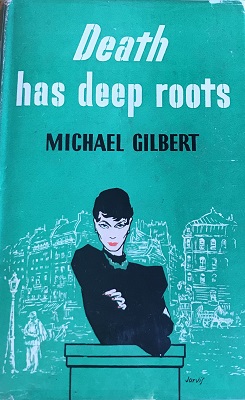
Death Has Deep Roots is the fifth novel by the British mystery writer Michael Gilbert. It was published in England by Hodder and Stoughton in 1951 and in the United States by Harper & Brothers in 1952. It is basically a classical courtroom trial story but with almost equally important thriller elements juxtaposed with the courtroom scenes. Although Inspector Hazlerigg, who had appeared in all of Gilbert's earlier novels as a mostly leading character, does play a role in this story, it is only in two brief appearances, once towards the beginning of the book and once again near the end. Two of the three main characters in this book are from previous novels, Major Angus McMann and Noel Anthony Pontarlier ("Nap") Rumbold. The other leading character, the trial barrister Hargest Macrae, also appears in some of Gilbert's early short stories.

Death in Captivity is a mystery novel by the British crime writer Michael Gilbert, first published in the United Kingdom in 1952 by Hodder and Stoughton and in the United States by Harper & Brothers as The Danger Within. It was Gilbert's sixth novel and, unlike his previous ones, does not feature Chief Inspector Hazlerigg in any way. Nor is it set in Gilbert's usual locales of London, the English countryside, or France. Instead, while it has many of the elements of the classic detective story, it is also a gripping novel of mounting suspense that takes place in a 1943 prisoner of war camp for British officers in northern Italy—it was the first of Gilbert's numerous later works that would feature suspense and danger as much or more as elements of detection. Gilbert himself had been a British officer during the war, was captured, and interned in an Italian camp. He escaped and spent several months making his way through the Italian countryside trying to reach the British lines. Much of this book apparently reflects his own experiences. It was the basis of a 1959 British film, Danger Within, that closely followed the events in the book. H.R.F. Keating, who wrote Gilbert's obituary for The Guardian, said that "Gilbert's time as a PoW prompted Death In Captivity (1952), surely the only whodunnit set in a prisoner-of-war camp."
Inspector Bill Mercer is a detective created by the British crime and mystery writer Michael Gilbert. He is the leading character in the 1972 novel The Body of a Girl, a somewhat hardboiled police procedural, and appears later in at least three short stories. On the first page of the novel, "Detective Inspector William Mercer received... confirmation of his promotion to chief inspector and his appointment in charge of the CID at Stoneferry on Thames, which is one of the larger upriver stations of Q Division of the Metropolitan Police."

















